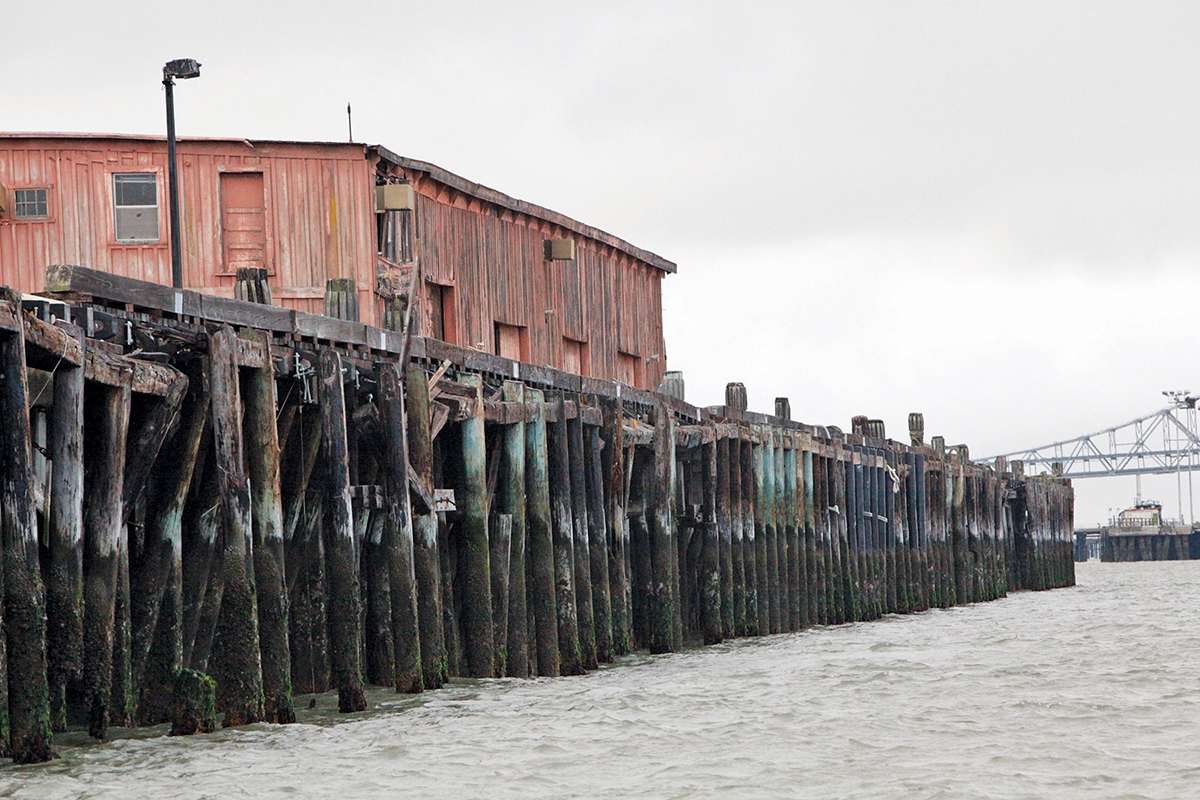
The eventual removal of the environmentally hazardous wharf and pilings at Terminal 4 in Richmond is one of the first Measure AA projects to be handled by the Bay Restoration Regulatory Integration Team. Photo courtesy California State Coastal Conservancy.
In 2016 the Bay Area voted on Measure AA, which will raise half a billion dollars to restore the tidal marshes that protect against rising tides. The measure passed in a landslide, prompting the team behind it to spring into action. “We have until about 2030 to establish wetlands in the bay before sea-level rise makes it infeasible because it’s too deep,” explained Adrian Covert, who is vice president of public policy for the Bay Area Council, a business-backed nonprofit that helped lead the Measure AA campaign. “We asked how to make sure we have success.”
The team identified two major obstacles to restoring the bay’s tidal marshes. One is that the supply of sediment needed for rebuilding wetlands is uncertain. The other is that it is difficult to get the permits required by half a dozen state and federal agencies for environmental projects. “It can take five to 10 years,” Covert said. “We have to speed permits or we’ll only have one round of projects completed in the 20-year life of Measure AA.”
Each agency — from the U.S. Army Corps of Engineers to the California Department of Fish and Wildlife to the Bay Conservation and Development Commission (BCDC) — has its own mandates, and these can conflict with each other. One agency may restrict public access, for example, while another may require it. In addition, one agency may approve converting open water and mudflats to tidal marsh, while another sees this as habitat loss for non-marsh species. “As a permit applicant, you’re hearing different things from different people,” said Brad McCrea, BCDC’s regulatory director.
Besides being time consuming, resolving these conflicts can be expensive. “Permitting can eat up a chunk of funding in staff time or consultant fees,” said Amy Hutzel, deputy executive officer at the California State Coastal Conservancy. In hopes of finding a better way to permit environmental projects, Measure AA leaders met with the six main permitting agencies.
This marked the beginning of an effort to streamline environmental permitting called the Bay Restoration Regulatory Integration Team (BRRIT). The team includes a dedicated permit analyst from each agency. “They usually don’t talk to each other,” Covert said. “BRRIT gets them in the same room so they can hash things out.”
Besides helping the agencies to coordinate, BRRIT also smooths the process by providing pre-application guidance. “Applicants meet with the permit analysts in advance of submission,” said Hutzel, the project manager for BRRIT. “The idea is to reduce all the back and forth.” Importantly, any project eligible for Measure AA — not just those that receive funding — can take advantage of BRRIT.
This new approach to environmental permitting also includes a policy team designed to help resolve conflicts among the permit analysts from the various agencies. “If they get stuck, we try to break the logjam and get the process moving again,” said BCDC’s McCrea, pointing to a recent BRRIT-driven change in his agency’s policy. While BCDC used to be required to limit additional fill in the bay regardless of the type of project, they now have the leeway to approve more fill for environmental restoration.
The first Measure AA projects that have gone all the way through BRRIT, starting with pre-application guidance, are about to submit permit applications. One of these projects, which is sponsored by the Coastal Conservancy and the City of Richmond, includes removing the derelict wharf and pilings at Terminal 4 in Richmond. This involved quite a bit of hashing out. These old pilings had been treated with creosote, a wood preservative toxic to marine life that is now banned, and the agencies initially had different opinions on the best way to remove them. Moving into the permit application phase will reveal whether — and how well — the agencies worked out their differences during the pre-application phase. “This will be a good test of BRRIT,” project manager Hutzel said.
Other Measure AA projects readying to submit permit applications through BRRIT include one by Marin County Parks and Open Space to restore 180 acres of diked wetlands in McInnis Park, which is on San Pablo Bay near San Rafael. Another, by the Santa Clara Valley Water District and the U.S. Army Corps of Engineers, will restore 4,700 acres of wetlands on former commercial salt ponds in the South Bay near San Jose. Likewise, a California Department of Fish and Wildlife/Coastal Conservancy project will restore 1,375 acres of wetlands on former commercial salt ponds near the mouth of Alameda Creek, which is near Union City.
Letitia Grenier, an ecologist at the San Francisco Estuary Institute, will be paying close attention to this first round of BRRIT projects. This summer she began a year-long fellowship on improving environmental permitting sponsored by the Public Policy Institute of California and the environmental nonprofit California Trout. “We’re in this race against time with climate change and with our own governmental structures,” Grenier said. “They’re so hard to change.” The problem is that regulations were written to prevent environmental destruction rather than to facilitate environmental restoration. “We can keep the environmental laws but update the policies,” she continued, which is in keeping with the BRRIT approach.
To help find ways forward, Grenier is gathering standout case studies of environmental permitting to identify what makes them so successful. Her goal is to provide recommendations for permitting agencies as well as for permittees. Possibilities include better agency coordination, as pioneered by BRRIT, as well as blanket permits that cover small projects by, for example, private landowners.
Wade Crowfoot, secretary for the California Natural Resources Agency, is tracking the outcome of BRRIT too. He recently launched a state-level initiative called Cutting Green Tape, which aims to reform government processes and requirements for permitting ecological restoration projects. “I am really excited to watch the progress of your BRRIT initiative that is a one-of-a-kind effort,” Crowfoot told BCDC at their May 2020 meeting. “Your efforts are really a poster child of that broader initiative.”
BCDC’s McCrea is optimistic about BRRIT. “We all want the same thing,” he said of permitting agencies and permit applicants for tidal marsh restoration projects on the shores of the bay. “It’s an unprecedented initiative — if it works it will be a national model.”
Robin Meadows covers water for the Monitor.

